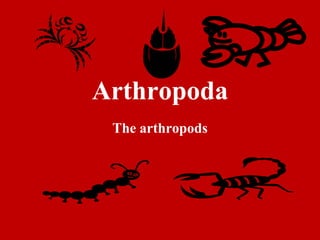
Arthropoda & echinodermata notes
- 2. Most successful animals on Earth… Over 75% of all animals are arthropods! Have bilateral symmetry with 3 tissue layers and organs/systems
- 3. They have a true coelom type of body cavity with a mouth and anus They eat everything! They reproduce sexually
- 4. These organisms live everywhere!
- 5. Diverse and most successful group of invertebrates The body is divided into 2 or 3 sections
- 8. Has a nervous system with brain and nerve cords Has an open-circulatory system with heart and arteries but no veins
- 9. Named for their jointed appendages Hard exoskeleton for protection; most must molt to grow